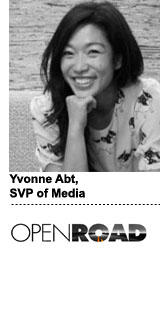
Data is changing the way movies are marketed.
Studios like Open Road Films are taking a more targeted approach to marketing, moving from broad-based buys – such as people aged 18 to 49 with a propensity for “dramas” – to more granular segmentation.
“When finding audiences for a particular film, it used to be really shortsighted, where you might have only considered other theatrical films an audience has consumed,” said Yvonne Abt, SVP of media for Open Road Films.
Entertainment marketers must also compete for consumer attention as more networks and video services, such as Netflix and Amazon Prime, boost their own program marketing in linear TV.
“Television used to be the sandbox for theatrical clients to gain awareness, but it’s become untenable to try to compete against all of those marketing dollars and attention-grabbing creative,” Abt said. “We needed to be scrappy and find other ways to get attention.”
That said, the film studio didn’t want to completely ignore television, despite a digital-first push to reach a female-skewing audience for the October release of “All I See Is You,” the psychological drama starring Blake Lively.
Working with its partner, Tremor Video DSP, Open Road Films studied data representing about 34 million homes with the TV data platform Alphonso.
It found that in particular, linear and over-the-top captured the most attention from the older-skewing female audience it was after.
Using Alphonso’s data, Open Road identified and isolated audiences based on what they watched across broadcast, cable and streaming, down to the program level.
The audiences were selected based on multiple “entry points” to the film, such as whether a viewer is more likely to be fan of thrillers, romances or strong female protagonists.
With this information, Open Road used Tremor Video to create 15 buckets of micro audience segments to target through mobile video. The goal was to send mobile ads that matched the context of the TV programming consumed just minutes before or after the show content aired.
“We were really trying to deliver a personalized ad experience on the personal device married to specific TV messages,” said Abbey Thomas, CMO of Tremor Video DSP.
Tremor Video’s in-house creative team worked with Open Road’s creative team to customize various messages to reach these female viewers, whether they were watching “Scandal” on network television or “Stranger Things” on Netflix.
Open Road designed about 11 different pieces of creative to help amplify its second-screen ads based on different viewer attributes.
“By combining data about different television and streaming programs, it really helped us ascertain which people would like which message and then optimize the creative around it,” Abt said.
For instance, if Open Road knew a consumer liked the program “Scandal,” it determined they were more likely to associate with a strong, flawed heroine and opt for creative geared toward that mindset.
By combining TV and mobile data and targeting viewers with more precision, Open Road generated moviegoer lift as high as 17%.
Ensuring proper frequency caps throughout the campaign’s life cycle can make or break the consumer’s cross-screen experience and impact conversion, said Abt, who previously worked with entertainment advertisers at agencies Horizon, UM and OMD.
“If we’ve seen someone has been exposed 10 to 15 times to our trailer and has shown other positive signs and signals, we may actually choose to dial down frequency so we can put more money toward people we still have to convince,” she said. “In that way, it doesn’t negatively impact consumers who have already seen the trailer, and we save a little bit of gas in the tank for those last-minute decision-makers.”
This post was syndicated from Ad Exchanger.

More Stories
Thompson Spencer expands across the ditch
Omnicom Grows 3.4%, Gains Regulatory Approval for IPG Deal in Some Markets
Auckland Rugby kicks off new community brand with Crave